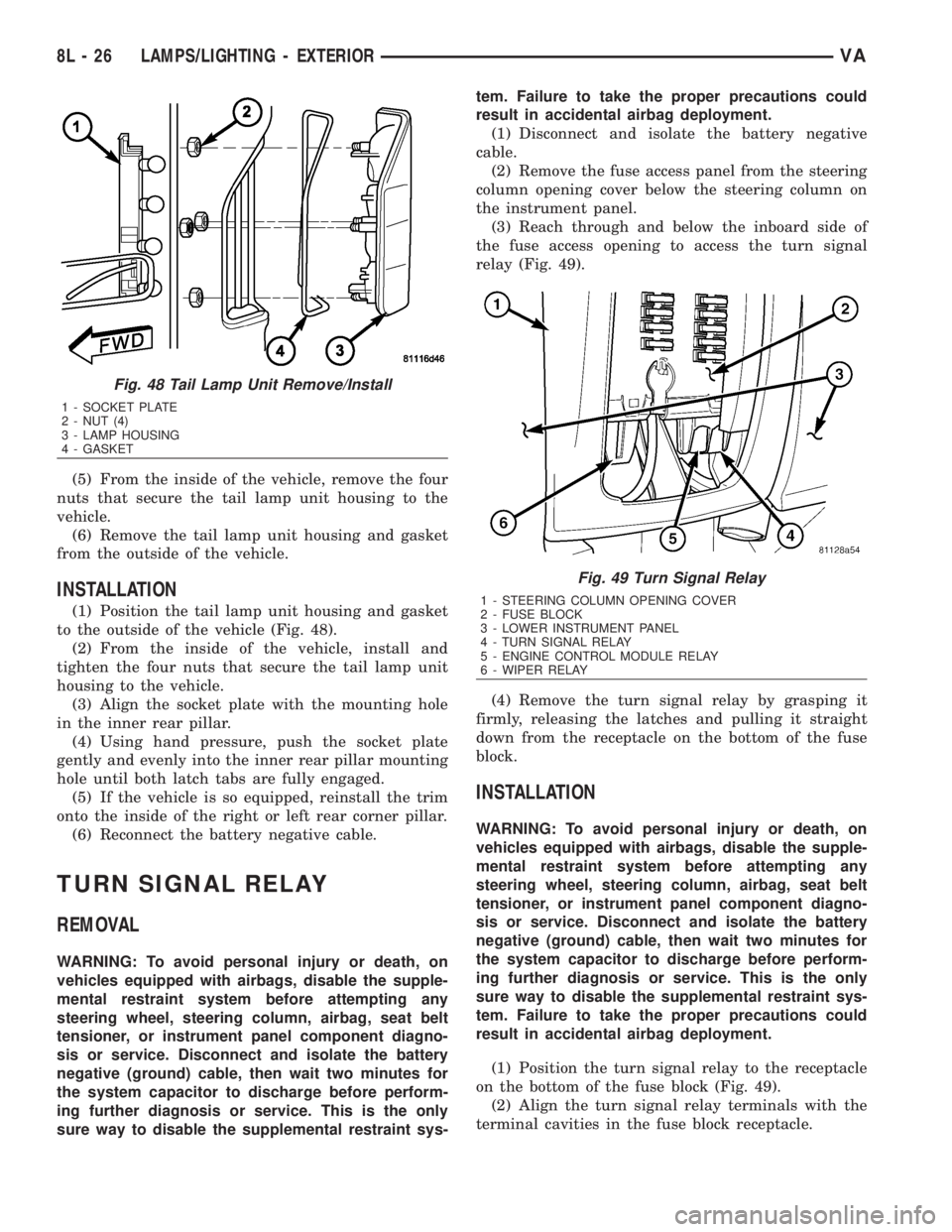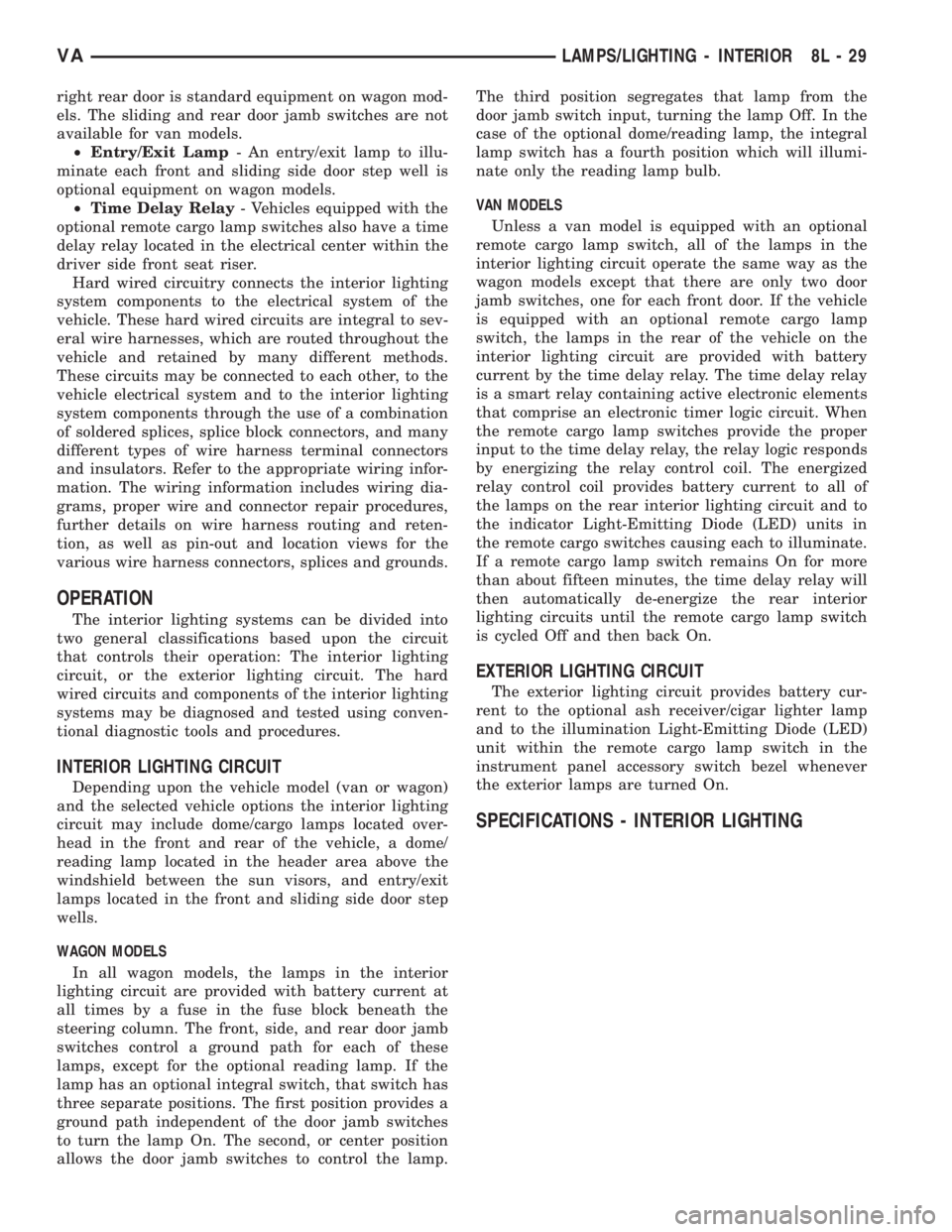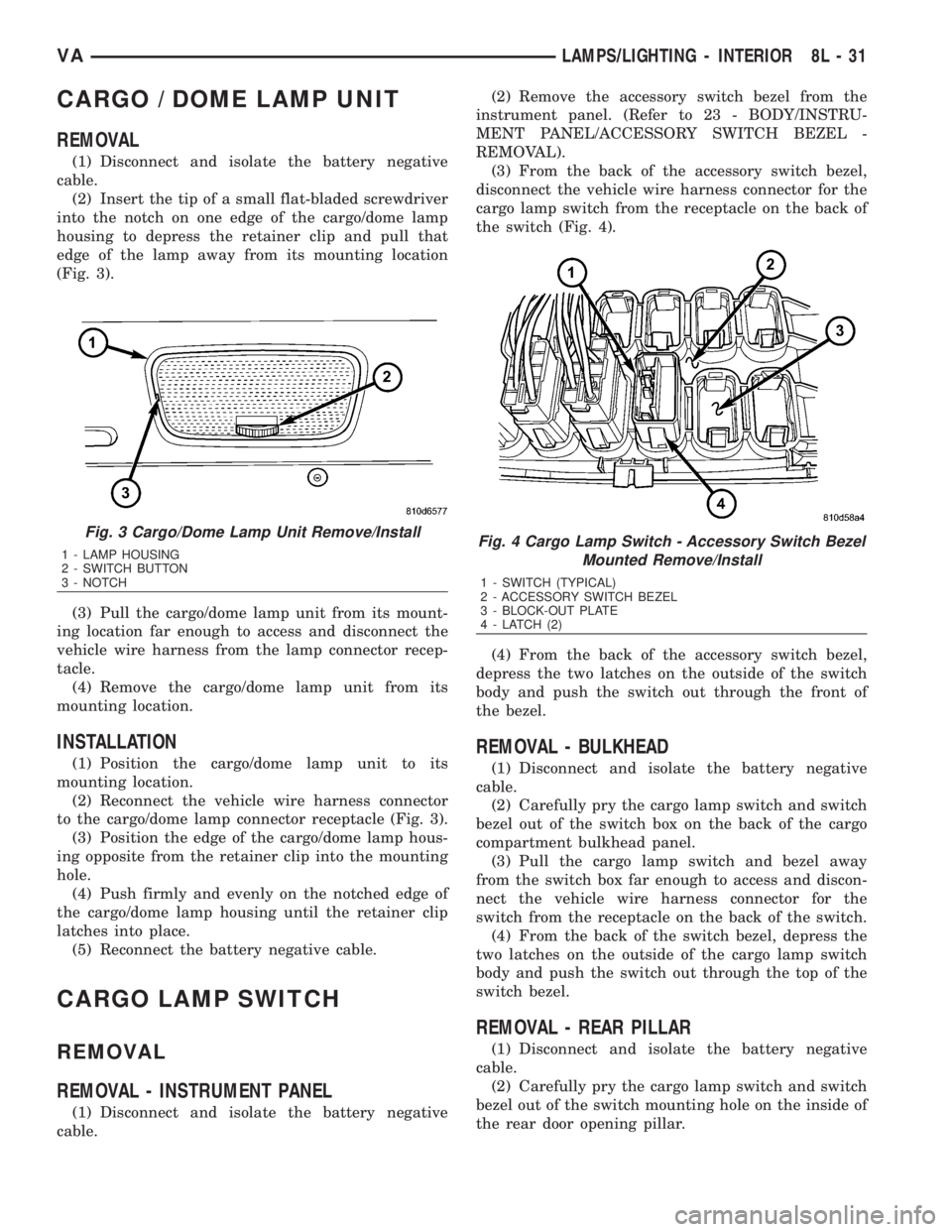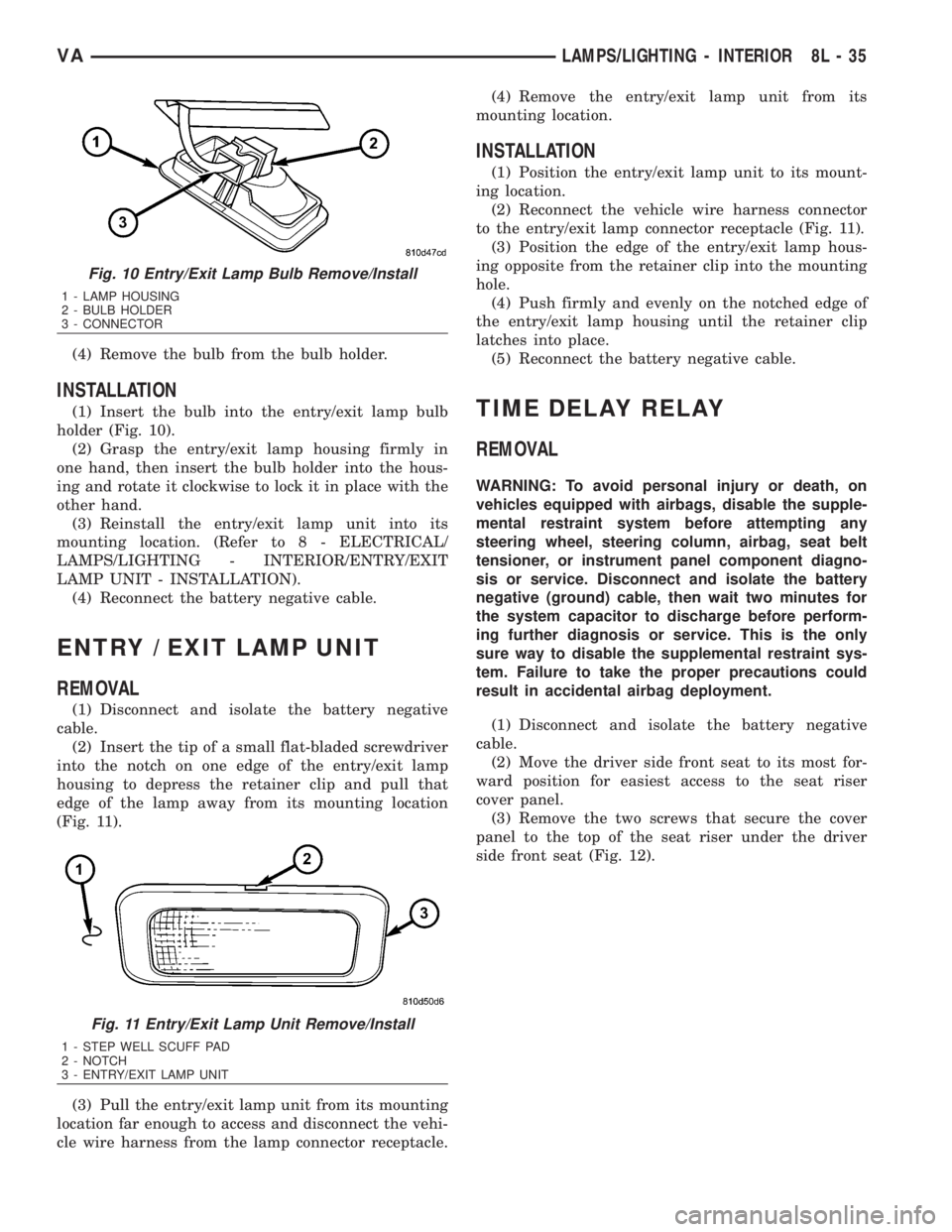2006 MERCEDES-BENZ SPRINTER lock
[x] Cancel search: lockPage 970 of 2305

MULTI - FUNCTION SWITCH
REMOVAL
WARNING: To avoid personal injury or death, on
vehicles equipped with airbags, disable the supple-
mental restraint system before attempting any
steering wheel, steering column, airbag, seat belt
tensioner, or instrument panel component diagno-
sis or service. Disconnect and isolate the battery
negative (ground) cable, then wait two minutes for
the system capacitor to discharge before perform-
ing further diagnosis or service. This is the only
sure way to disable the supplemental restraint sys-
tem. Failure to take the proper precautions could
result in accidental airbag deployment.
(1) Disconnect and isolate the battery negative
cable.
(2) Remove the fuse block from the underside of
the steering column. (Refer to 8 - ELECTRICAL/
POWER DISTRIBUTION/FUSE BLOCK -
REMOVAL).
(3) Remove the clockspring from the steering col-
umn. (Refer to 8 - ELECTRICAL/RESTRAINTS/
CLOCKSPRING - REMOVAL).
(4) If the vehicle is so equipped, remove the steer-
ing angle sensor from the steering column. (Refer to
5 - BRAKES/ELECTRICAL/STEERING ANGLE
SENSOR - REMOVAL).
(5) Remove the two screws that secure the upper
shroud to the top of the multi-function switch (Fig.
37).
(6) Remove the upper shroud from the top of the
multi-function switch.
(7) Remove the two screws that secure the multi-
function switch to the steering column.(8) Remove the multi-function switch from the
steering column.
(9) Remove the speed control switch from the back
of the multi-function switch. (Refer to 8 - ELECTRI-
CAL/SPEED CONTROL/SWITCH - REMOVAL).
INSTALLATION
WARNING: To avoid personal injury or death, on
vehicles equipped with airbags, disable the supple-
mental restraint system before attempting any
steering wheel, steering column, airbag, seat belt
tensioner, or instrument panel component diagno-
sis or service. Disconnect and isolate the battery
negative (ground) cable, then wait two minutes for
the system capacitor to discharge before perform-
ing further diagnosis or service. This is the only
sure way to disable the supplemental restraint sys-
tem. Failure to take the proper precautions could
result in accidental airbag deployment.
(1) Reinstall the speed control switch onto the
back of the multi-function switch. (Refer to 8 - ELEC-
TRICAL/SPEED CONTROL/SWITCH - INSTALLA-
TION).
(2) Position the multi-function switch onto the
steering column (Fig. 37).
(3) Install and tighten the two screws that secure
the multi-function switch to the steering column.
(4) Position the upper shroud onto the top of the
multi-function switch.
(5) Install and tighten the two screws that secure
the upper shroud to the top of the multi-function
switch.
(6) If the vehicle is so equipped, reinstall the steer-
ing angle sensor onto the steering column. (Refer to 5
- BRAKES/ELECTRICAL/STEERING ANGLE SEN-
SOR - INSTALLATION).
(7) Reinstall the clockspring onto the steering col-
umn. (Refer to 8 - ELECTRICAL/RESTRAINTS/
CLOCKSPRING - INSTALLATION).
(8) Reinstall the fuse block onto the underside of
the steering column. (Refer to 8 - ELECTRICAL/
POWER DISTRIBUTION/FUSE BLOCK - INSTAL-
LATION).
(9) Reconnect the battery negative cable.
PARK BRAKE SWITCH
REMOVAL
(1) Remove the trim cover from the park brake
lever (Fig. 38). (Refer to 5 - BRAKES/PARKING
BRAKE/LEVER - REMOVAL).
Fig. 37 Multi-Function Switch Remove/Install
1 - SCREW (2)
2 - UPPER SHROUD
3 - SWITCH
4 - SCREW (2)
VALAMPS/LIGHTING - EXTERIOR 8L - 21
Page 975 of 2305

(5) From the inside of the vehicle, remove the four
nuts that secure the tail lamp unit housing to the
vehicle.
(6) Remove the tail lamp unit housing and gasket
from the outside of the vehicle.
INSTALLATION
(1) Position the tail lamp unit housing and gasket
to the outside of the vehicle (Fig. 48).
(2) From the inside of the vehicle, install and
tighten the four nuts that secure the tail lamp unit
housing to the vehicle.
(3) Align the socket plate with the mounting hole
in the inner rear pillar.
(4) Using hand pressure, push the socket plate
gently and evenly into the inner rear pillar mounting
hole until both latch tabs are fully engaged.
(5) If the vehicle is so equipped, reinstall the trim
onto the inside of the right or left rear corner pillar.
(6) Reconnect the battery negative cable.
TURN SIGNAL RELAY
REMOVAL
WARNING: To avoid personal injury or death, on
vehicles equipped with airbags, disable the supple-
mental restraint system before attempting any
steering wheel, steering column, airbag, seat belt
tensioner, or instrument panel component diagno-
sis or service. Disconnect and isolate the battery
negative (ground) cable, then wait two minutes for
the system capacitor to discharge before perform-
ing further diagnosis or service. This is the only
sure way to disable the supplemental restraint sys-tem. Failure to take the proper precautions could
result in accidental airbag deployment.
(1) Disconnect and isolate the battery negative
cable.
(2) Remove the fuse access panel from the steering
column opening cover below the steering column on
the instrument panel.
(3) Reach through and below the inboard side of
the fuse access opening to access the turn signal
relay (Fig. 49).
(4) Remove the turn signal relay by grasping it
firmly, releasing the latches and pulling it straight
down from the receptacle on the bottom of the fuse
block.
INSTALLATION
WARNING: To avoid personal injury or death, on
vehicles equipped with airbags, disable the supple-
mental restraint system before attempting any
steering wheel, steering column, airbag, seat belt
tensioner, or instrument panel component diagno-
sis or service. Disconnect and isolate the battery
negative (ground) cable, then wait two minutes for
the system capacitor to discharge before perform-
ing further diagnosis or service. This is the only
sure way to disable the supplemental restraint sys-
tem. Failure to take the proper precautions could
result in accidental airbag deployment.
(1) Position the turn signal relay to the receptacle
on the bottom of the fuse block (Fig. 49).
(2) Align the turn signal relay terminals with the
terminal cavities in the fuse block receptacle.
Fig. 48 Tail Lamp Unit Remove/Install
1 - SOCKET PLATE
2 - NUT (4)
3 - LAMP HOUSING
4 - GASKET
Fig. 49 Turn Signal Relay
1 - STEERING COLUMN OPENING COVER
2 - FUSE BLOCK
3 - LOWER INSTRUMENT PANEL
4 - TURN SIGNAL RELAY
5 - ENGINE CONTROL MODULE RELAY
6 - WIPER RELAY
8L - 26 LAMPS/LIGHTING - EXTERIORVA
Page 976 of 2305

(3) Push firmly and evenly on the top of the turn
signal relay until the terminals are fully seated in
the terminal cavities in the receptacle of the fuse
block and both latches are fully engaged.
(4) Reinstall the fuse access panel onto the steer-
ing column opening cover below the steering column
on the instrument panel.
(5) Reconnect the battery negative cable.
VALAMPS/LIGHTING - EXTERIOR 8L - 27
Page 978 of 2305

right rear door is standard equipment on wagon mod-
els. The sliding and rear door jamb switches are not
available for van models.
²Entry/Exit Lamp- An entry/exit lamp to illu-
minate each front and sliding side door step well is
optional equipment on wagon models.
²Time Delay Relay- Vehicles equipped with the
optional remote cargo lamp switches also have a time
delay relay located in the electrical center within the
driver side front seat riser.
Hard wired circuitry connects the interior lighting
system components to the electrical system of the
vehicle. These hard wired circuits are integral to sev-
eral wire harnesses, which are routed throughout the
vehicle and retained by many different methods.
These circuits may be connected to each other, to the
vehicle electrical system and to the interior lighting
system components through the use of a combination
of soldered splices, splice block connectors, and many
different types of wire harness terminal connectors
and insulators. Refer to the appropriate wiring infor-
mation. The wiring information includes wiring dia-
grams, proper wire and connector repair procedures,
further details on wire harness routing and reten-
tion, as well as pin-out and location views for the
various wire harness connectors, splices and grounds.
OPERATION
The interior lighting systems can be divided into
two general classifications based upon the circuit
that controls their operation: The interior lighting
circuit, or the exterior lighting circuit. The hard
wired circuits and components of the interior lighting
systems may be diagnosed and tested using conven-
tional diagnostic tools and procedures.
INTERIOR LIGHTING CIRCUIT
Depending upon the vehicle model (van or wagon)
and the selected vehicle options the interior lighting
circuit may include dome/cargo lamps located over-
head in the front and rear of the vehicle, a dome/
reading lamp located in the header area above the
windshield between the sun visors, and entry/exit
lamps located in the front and sliding side door step
wells.
WAGON MODELS
In all wagon models, the lamps in the interior
lighting circuit are provided with battery current at
all times by a fuse in the fuse block beneath the
steering column. The front, side, and rear door jamb
switches control a ground path for each of these
lamps, except for the optional reading lamp. If the
lamp has an optional integral switch, that switch has
three separate positions. The first position provides a
ground path independent of the door jamb switches
to turn the lamp On. The second, or center position
allows the door jamb switches to control the lamp.The third position segregates that lamp from the
door jamb switch input, turning the lamp Off. In the
case of the optional dome/reading lamp, the integral
lamp switch has a fourth position which will illumi-
nate only the reading lamp bulb.
VAN MODELS
Unless a van model is equipped with an optional
remote cargo lamp switch, all of the lamps in the
interior lighting circuit operate the same way as the
wagon models except that there are only two door
jamb switches, one for each front door. If the vehicle
is equipped with an optional remote cargo lamp
switch, the lamps in the rear of the vehicle on the
interior lighting circuit are provided with battery
current by the time delay relay. The time delay relay
is a smart relay containing active electronic elements
that comprise an electronic timer logic circuit. When
the remote cargo lamp switches provide the proper
input to the time delay relay, the relay logic responds
by energizing the relay control coil. The energized
relay control coil provides battery current to all of
the lamps on the rear interior lighting circuit and to
the indicator Light-Emitting Diode (LED) units in
the remote cargo switches causing each to illuminate.
If a remote cargo lamp switch remains On for more
than about fifteen minutes, the time delay relay will
then automatically de-energize the rear interior
lighting circuits until the remote cargo lamp switch
is cycled Off and then back On.
EXTERIOR LIGHTING CIRCUIT
The exterior lighting circuit provides battery cur-
rent to the optional ash receiver/cigar lighter lamp
and to the illumination Light-Emitting Diode (LED)
unit within the remote cargo lamp switch in the
instrument panel accessory switch bezel whenever
the exterior lamps are turned On.
SPECIFICATIONS - INTERIOR LIGHTING
VALAMPS/LIGHTING - INTERIOR 8L - 29
Page 980 of 2305

CARGO / DOME LAMP UNIT
REMOVAL
(1) Disconnect and isolate the battery negative
cable.
(2) Insert the tip of a small flat-bladed screwdriver
into the notch on one edge of the cargo/dome lamp
housing to depress the retainer clip and pull that
edge of the lamp away from its mounting location
(Fig. 3).
(3) Pull the cargo/dome lamp unit from its mount-
ing location far enough to access and disconnect the
vehicle wire harness from the lamp connector recep-
tacle.
(4) Remove the cargo/dome lamp unit from its
mounting location.
INSTALLATION
(1) Position the cargo/dome lamp unit to its
mounting location.
(2) Reconnect the vehicle wire harness connector
to the cargo/dome lamp connector receptacle (Fig. 3).
(3) Position the edge of the cargo/dome lamp hous-
ing opposite from the retainer clip into the mounting
hole.
(4) Push firmly and evenly on the notched edge of
the cargo/dome lamp housing until the retainer clip
latches into place.
(5) Reconnect the battery negative cable.
CARGO LAMP SWITCH
REMOVAL
REMOVAL - INSTRUMENT PANEL
(1) Disconnect and isolate the battery negative
cable.(2) Remove the accessory switch bezel from the
instrument panel. (Refer to 23 - BODY/INSTRU-
MENT PANEL/ACCESSORY SWITCH BEZEL -
REMOVAL).
(3) From the back of the accessory switch bezel,
disconnect the vehicle wire harness connector for the
cargo lamp switch from the receptacle on the back of
the switch (Fig. 4).
(4) From the back of the accessory switch bezel,
depress the two latches on the outside of the switch
body and push the switch out through the front of
the bezel.
REMOVAL - BULKHEAD
(1) Disconnect and isolate the battery negative
cable.
(2) Carefully pry the cargo lamp switch and switch
bezel out of the switch box on the back of the cargo
compartment bulkhead panel.
(3) Pull the cargo lamp switch and bezel away
from the switch box far enough to access and discon-
nect the vehicle wire harness connector for the
switch from the receptacle on the back of the switch.
(4) From the back of the switch bezel, depress the
two latches on the outside of the cargo lamp switch
body and push the switch out through the top of the
switch bezel.
REMOVAL - REAR PILLAR
(1) Disconnect and isolate the battery negative
cable.
(2) Carefully pry the cargo lamp switch and switch
bezel out of the switch mounting hole on the inside of
the rear door opening pillar.
Fig. 3 Cargo/Dome Lamp Unit Remove/Install
1 - LAMP HOUSING
2 - SWITCH BUTTON
3 - NOTCHFig. 4 Cargo Lamp Switch - Accessory Switch Bezel
Mounted Remove/Install
1 - SWITCH (TYPICAL)
2 - ACCESSORY SWITCH BEZEL
3 - BLOCK-OUT PLATE
4 - LATCH (2)
VALAMPS/LIGHTING - INTERIOR 8L - 31
Page 982 of 2305

(3) Pull the dome/reading lamp unit from its
mounting location far enough to access and discon-
nect the vehicle wire harness from the lamp connec-
tor receptacle.
(4) Remove the dome/reading lamp unit from its
mounting location.
INSTALLATION
(1) Position the dome/reading lamp unit to its
mounting location.
(2) Reconnect the vehicle wire harness connector
to the dome/reading lamp connector receptacle (Fig.
6).
(3) Position the edge of the dome/reading lamp
housing opposite from the retainer clip into the
mounting hole.
(4) Push firmly and evenly on the notched edge of
the dome/reading lamp housing until the retainer
clip latches into place.
(5) Reconnect the battery negative cable.
DOME LAMP / INTRUSION
SENSOR BULB
REMOVAL
(1) Disconnect and isolate the battery negative
cable.
(2) Remove the dome lamp/intrusion sensor unit
from its mounting location, but do not disconnect the
vehicle wire harness from the lamp connector recep-
tacle. (Refer to 8 - ELECTRICAL/LAMPS/LIGHTING
- INTERIOR/DOME LAMP/INTRUSION SENSOR
UNIT - REMOVAL).
(3) Grasp the lamp housing in one hand and rotate
the bulb holder and bulb unit counterclockwise about
30 degrees on the circuit board (Fig. 7).(4) Pull the bulb holder and bulb unit straight out
from the mounting hole in the circuit board.
INSTALLATION
(1) Grasp the dome lamp/intrusion sensor unit
housing in one hand and align the bulb holder and
bulb unit with the bulb mounting hole in the circuit
board with the other hand (Fig. 7).
(2) Insert the bulb holder and bulb unit straight
into the circuit board bulb mounting hole until it is
firmly seated.
(3) Rotate the bulb holder and bulb unit clockwise
about 30 degrees on the circuit board.
(4) Reinstall the dome lamp/intrusion sensor unit
into its mounting location. (Refer to 8 - ELECTRI-
CAL/LAMPS/LIGHTING - INTERIOR/DOME LAMP/
INTRUSION SENSOR UNIT - INSTALLATION).
(5) Reconnect the battery negative cable.
DOME LAMP / INTRUSION
SENSOR
REMOVAL
(1) Disconnect and isolate the battery negative
cable.
(2) Insert the tip of a small flat-bladed screwdriver
into the notch on one edge of the dome lamp/intru-
sion sensor unit housing to depress the retainer clip
and pull that edge of the lamp away from its mount-
ing location (Fig. 8).
Fig. 6 Dome/Reading Lamp Unit Remove/Install
1 - LAMP HOUSING
2 - SWITCH BUTTON
3 - NOTCH
4 - SUN VISOR (2)
5 - HEADLINER
Fig. 7 Dome Lamp/Intrusion Sensor Bulb Remove/
Install
1 - BULB HOLDER/BULB (4)
2 - LAMP HOUSING
VALAMPS/LIGHTING - INTERIOR 8L - 33
Page 983 of 2305

(3) Pull the dome lamp/intrusion sensor unit from
its mounting location far enough to access and dis-
connect the vehicle wire harness from the lamp con-
nector receptacle.
(4) Remove the dome lamp/intrusion sensor unit
from its mounting location.
INSTALLATION
(1) Position the dome lamp/intrusion sensor unit to
its mounting location (Fig. 8).
(2) Reconnect the vehicle wire harness connector
to the dome lamp/intrusion sensor unit connector
receptacle.
(3) Position the edge of the dome lamp/intrusion
sensor unit housing opposite from the retainer clip
into the mounting hole.
(4) Push firmly and evenly on the notched edge of
the dome lamp/intrusion sensor unit housing until
the retainer clip latches into place.
(5) Reconnect the battery negative cable.
DOOR JAMB SWITCH
REMOVAL
(1) Disconnect and isolate the battery negative
cable.
(2) Open the door and remove the screw that
secures the door jamb switch to the hinge pillar of
the door opening (Fig. 9).(3) Pull the door jamb switch away from the
mounting hole in the pillar far enough to access and
disconnect the vehicle wire harness connector from
the back of the switch.
INSTALLATION
(1) Position the door jamb switch close enough to
the mounting hole in the hinge pillar of the door
opening to reconnect the vehicle wire harness connec-
tor to the back of the switch.
(2) Position the door jamb switch into the mount-
ing hole in the hinge pillar (Fig. 9).
(3) Install and tighten the screw that secures the
door jamb switch to the hinge pillar.
(4) Reconnect the battery negative cable.
ENTRY / EXIT LAMP BULB
REMOVAL
(1) Disconnect and isolate the battery negative
cable.
(2) Remove the entry/exit lamp unit from its
mounting location. (Refer to 8 - ELECTRICAL/
LAMPS/LIGHTING - INTERIOR/ENTRY/EXIT
LAMP UNIT - REMOVAL).
(3) Grasp the lamp housing firmly in one hand,
then rotate the bulb holder counterclockwise and pull
it straight out from the housing with the other hand
(Fig. 10).
Fig. 8 Dome Lamp/Intrusion Sensor Unit Remove/
Install
1 - NOTCH
2 - SENSOR (3)
3 - HOUSING
4 - SWITCH (2)
Fig. 9 Door Jamb Switch Remove/Install
1 - DOOR JAMB SWITCH
2 - PLUNGER
3 - PILLAR
4 - SCREW
8L - 34 LAMPS/LIGHTING - INTERIORVA
Page 984 of 2305

(4) Remove the bulb from the bulb holder.
INSTALLATION
(1) Insert the bulb into the entry/exit lamp bulb
holder (Fig. 10).
(2) Grasp the entry/exit lamp housing firmly in
one hand, then insert the bulb holder into the hous-
ing and rotate it clockwise to lock it in place with the
other hand.
(3) Reinstall the entry/exit lamp unit into its
mounting location. (Refer to 8 - ELECTRICAL/
LAMPS/LIGHTING - INTERIOR/ENTRY/EXIT
LAMP UNIT - INSTALLATION).
(4) Reconnect the battery negative cable.
ENTRY / EXIT LAMP UNIT
REMOVAL
(1) Disconnect and isolate the battery negative
cable.
(2) Insert the tip of a small flat-bladed screwdriver
into the notch on one edge of the entry/exit lamp
housing to depress the retainer clip and pull that
edge of the lamp away from its mounting location
(Fig. 11).
(3) Pull the entry/exit lamp unit from its mounting
location far enough to access and disconnect the vehi-
cle wire harness from the lamp connector receptacle.(4) Remove the entry/exit lamp unit from its
mounting location.
INSTALLATION
(1) Position the entry/exit lamp unit to its mount-
ing location.
(2) Reconnect the vehicle wire harness connector
to the entry/exit lamp connector receptacle (Fig. 11).
(3) Position the edge of the entry/exit lamp hous-
ing opposite from the retainer clip into the mounting
hole.
(4) Push firmly and evenly on the notched edge of
the entry/exit lamp housing until the retainer clip
latches into place.
(5) Reconnect the battery negative cable.
TIME DELAY RELAY
REMOVAL
WARNING: To avoid personal injury or death, on
vehicles equipped with airbags, disable the supple-
mental restraint system before attempting any
steering wheel, steering column, airbag, seat belt
tensioner, or instrument panel component diagno-
sis or service. Disconnect and isolate the battery
negative (ground) cable, then wait two minutes for
the system capacitor to discharge before perform-
ing further diagnosis or service. This is the only
sure way to disable the supplemental restraint sys-
tem. Failure to take the proper precautions could
result in accidental airbag deployment.
(1) Disconnect and isolate the battery negative
cable.
(2) Move the driver side front seat to its most for-
ward position for easiest access to the seat riser
cover panel.
(3) Remove the two screws that secure the cover
panel to the top of the seat riser under the driver
side front seat (Fig. 12).
Fig. 10 Entry/Exit Lamp Bulb Remove/Install
1 - LAMP HOUSING
2 - BULB HOLDER
3 - CONNECTOR
Fig. 11 Entry/Exit Lamp Unit Remove/Install
1 - STEP WELL SCUFF PAD
2 - NOTCH
3 - ENTRY/EXIT LAMP UNIT
VALAMPS/LIGHTING - INTERIOR 8L - 35